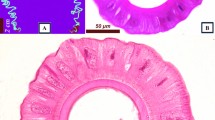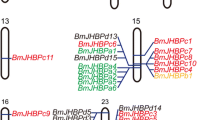Abstract
Parthenogenetic strains of silkworm serve as an effective system for sex-control in silkworms. To determine the molecular mechanism of silkworm parthenogenesis, protein profiles from newly hatched silkworm of a parthenogenetic lines with high pigmentation rate and hatching rate were compared with amphigenetic lines using proteomics approach, including by two-dimensional electrophoresis (2-DE), matrix-assisted laser desorption/ionization time-of-flight mass spectrometry (MALDI-TOF/TOF MS), and bioinformatics analysis. Several proteins were expressed differentially between the parthenogenetic and amphigenetic lines, and seven of nine interesting proteins were identified successfully using MALDI-TOF/TOF MS analysis. The identified proteins were muscular protein-20, odorant binding protein-LOC100301497, glutathione S-transferase delta, translationally controlled tumor protein homolog, cuticular protein RR-1 motif 19, beta-actin, actins, and muscle-type A1 actins. These proteins may be associated with the regulation of growth, development, and reproductive processes of silkworm parthenogenetic lines.
Similar content being viewed by others
References
Kirkendall, L. R. and B. Normark (2003) Parthenogenesis in encyclopaedia of insects. pp. 851–856. In: Vincent H. Resh and R. T. Carde (eds.). Academic Press.
Strunnikov, V. A. (1995) Control over reproduction sex and heterosis of the silkworm. pp. 8–20. Moscow: Harwood Academic Publishers.
Klymenko, V. V. (2001) Parthenogenesis and cloning in the silkworm Bombyx mori L.: Problems and prospects. J. Insect. Biotechnol. Sericol. 70: 155–165.
Xu, A. Y., M. W. Li, P. J. Sun, Y. H. Zhang, and C. X. Hou (2004) Review on silkworm (Bombyx mori) sex control in China. Int. J. Indust. Entomol. 8: 123–127.
Tichomirov, A. A. (1886) Die künstliche parthenogenese bei insecten. Arch. Anat. Physiol. Abt. Suppl. Bd. 35–36.
Gangopadhyay, D., R. Singh, B. K. Kariappa, and S. B. Dandin (2005) Parthenogenesis in silkworm, Bombyx mori L.. Int. J. Indust. Entomol. 10: 1–10.
Astaurov, B. L. (1940) Artificial parthenogenesis in the silkworm (Bombyx mori L.). An experimental study, Moscow: USSR Academy Press Astaurov. 221–240.
Pan, Q. Z., Y. L. Chen, J. W. Chen, J. R. Lin, and Z. R. Huang (1994) Sex control of silkworm Bombyx mori by using sensitive character to incubating temperature and humidity. Chin. Sci. Bull. 39: 67–67.
Chen, J. E., B. L. Niu, Y. Q. Wang, Y. Liu, P. G. Liu, Z. Q. Meng, and B. X. Zhong (2012) Proteome analysis on lethal effect of l 2 in the sex-linked balanced lethal strains of silkworm, Bombyx mori. Biotechnol. Bioproc. Eng. 17: 298–308.
He, K. R., X. R. Zhu, X. J. Liu, J.G. Xia, J. H. Huang, L. S. Yao, and Y. Q. Wang (2006) The breeding of male silkworm combination Qiuhua×Ping 30. Scientia. Agricultura. Sinica. 39: 1272–1276.
Wang, Y. Q., K. R. He, X. R. Zhu, X. J. Liu, X. L. He, and Y. T. Yao (2008) Studies on construction of female silkworm parthenogenetic clones and its application. Bull. Seri. 39: 8–10.
Wang, Y.Q., X. R. Zhu, K. R. He, Y. T. Yao, J. R. Cao, J. Q. Zhou, Y. F. Huang, X. J. Liu, X. L. He, and Z. Q. Meng (2010) The breeding and application of new male silkworm varieties by using female silkworm parthenogenetic clones. Sci. Seri. 36: 268–273.
Tonge, R., J. Shaw, B. Middleton, R. Rowlinson, S. Rayner, J. Young, F. Pognan, E. Hawkins, I. Currie, and M. Davison (2001) Validation and development of fluorescence two-dimensional differential gel electrophoresis Proteomics technology. Proteomics. 1: 377–396.
Liu, P. G., Y. Q. Wang, J. E. Chen, X. L. He, and W. G. Li (2010) A comparative proteomic analysis on hemolymph of Bombyx mori parthenogenetic line and parent of amphigenetic line. Sci. Seri. 36: 243–249.
Zhou, Z. H., H. J. Yang, and B. X. Zhong (2008) From genome to proteome: Great progress in the domesticated silkworm (Bombyx mori L.). Acta. Biochim. Biophys. Sin. 40: 601–611.
Li, X. H., X. F. Wu, W. F. Yue, J. M. Liu, G. L. Li, and Y. G. Miao (2006) Proteomic analysis of the silkworm (Bombyx mori L.) hemolymph during developmental stage. J. Proteome. Res. 5: 2809–2814.
Frolova, S. L. (1948) Cytology of artifilcial parthenogensis in Bombxy mori L.II.cytology of maturation and development on activation with high temperautre. Histol. Embryol. 3: 162–185.
Vereiskaya, V. N. (1975) Meiosis and the beginning of cleavage in thermally activated ovicells of the silkworm. Byull. Mos. Obsch. Isp. Prirody. Otd. Biol. 80: 31–40.
Bradford, M. M. (1976) A rapid and sensitive method for the quantitation of microgram quantities of protein utilizing the principle of protein-dye binding. Anal. Biochem. 72: 248–254.
Doherty, G. J. and H. T. McMahon (2008) Mediation, modulation, and consequences of membrane-cytoskeleton interactions. Annu. Rev. Biophys. 37: 65–95.
Yi, K., J. R. Unruh, M. Deng, B. D. Slaughter, B. Rubinstein, and R. Li (2011) Dynamic maintenance of asymmetric meiotic spindle position through Arp2/3-complex-driven cytoplasmic streaming in mouse oocytes. Nat. Cell. Biol. 13: 1252–1258.
Riparbelli, M. G., D. Tagu, J. Bonhomme, and G. Callami (2005) Aster self-organization at meiosis: A conserved mechanism in insect parthenogenesis? Dev. Biol. 278: 220–230.
Yang, P., W. W. Zhou, Q. Zhang, J. A. Cheng, Z. R. Zhu, and M. Wang (2009) Differential gene expression profiling in the developed ovaries between the parthenogenetic and bisexual female rice water weevils, Lissorhoptrus oryzophilus Kuschel (Coleoptera: Curculionidae). Chin. Sci. Bull. 54: 3822–3829.
Xu, X. Q., S. H. Song, Q. Wang, F. Qin, K. Liu, K. W. Zhang, S. N. Hu, and Y. L. Zhao (2009) Analysis and comparison of a set of expressed sequence tags of the parthenogenetic water flea Daphnia carinata. Mol. Genet. Genomics. 282: 197–203.
Agnes, A.-S., P. Lasko, C. French, and M. L. Pardue (1989) Characterization of the gene for mp20: A drosophila muscle protein that is not found in asynchronous oscillatory flight muscle. J. Cell. Biol. 108: 521–531.
Wnuk, W., J. A. Cox, and E. A. Stein (1982) Parvalbumins and other soluble high affinity calcium-binding proteins from muscle. pp. 243–278. Vol. 2. In: W. Y. Cheung (ed.). Calcium and Cell Function. Academic Press Inc., NY, USA.
Cortes, T., D. Tagu, J. C. Simon, A. Moya, and D. Martinez-Torres (2008) Sex versus parthenogenesis: A transcriptomic approach of photoperiod response in the model aphid Acyrthosiphon pisum (Hemiptera: Aphididae). Gene. 408: 146–156.
Baker, D. A., L. A. Meadows, J. Wang, J. A. T. Dow, and S. Russell (2007) Variable sexually dimorphic gene expression in laboratory strains of Drosophila melanogaster. BMC. Genomics.8: 453–462.
Sawicki, R., S. P. Singh, A. K. Mondal, H. Benes, and P. Zimniak (2003) Cloning, expression and biochemical characterization of one epsilon-class (GST-3) and ten delta-class (GST-1) glutathione S-transferases from Drosophila melanogaster, and identification of additional nine members of the Epsilon class. J. Biochem. 370: 661–669.
Vararattanavech, A., P. Prommeenate, and A. J. Ketterman (2006) The structural roles of a conserved small hydrophobic core in the active site and an ionic bridge in domain I of Delta class glutathione S-transferase. J. Biochem. 393: 89–95.
Sheehan, D., G. Meade, V. M. Foley, and C. A. Dowd (2001) Structure, function and evolution of glutathione transferases: Implications for classification of non-mammalian members of an ancient enzyme superfamily. J. Biochem. 360: 1–16.
Tarín, J. J., V. Gómez-Piquer, J. F. Pertusa, C. Hermenegildo, and A. Cano (2004) Association of female aging with decreased parthenogenetic activation, raised MPF, and MAPKs activities and reduced levels of glutathione S-transferases activity and thiols in mouse oocytes. Mol. Reprod. Dev. 69: 402–410.
Wang, Y. M., D. G. Xia, Y. S. Zhan, X. J. Ren, Y. D. Wei, and G. Z. Zhang (2009) SSH cDNA library construction and sequence analysis from the autogenesis is early embryo in the silkworm, Bombyx mori. Acta. Sericologica. Sinica. 35: 476–485.
Acín, P., M. Carrascal, J. Abián, A. Guerrero, and C. Quero (2009) Expression of differential antennal proteins in males and females of an important crop pest, Sesamia nonagrioides. Insect. Biochem. Mol. Biol. 39: 11–19.
Gong, D. P., H. J. Zhang, P. Zhao, Q. Y. Xia, and Z. H. Xiang (2009) The odorant binding protein gene family from the genome of silkworm, Bombyx mori. BMC. Genomcs. 10: 332.
Bommer, U. A. and B. J. Thiele (2004) The translationally controlled tumor protein (TCTP). Int. J. Biochem. Cell. Bin. 36: 379–385.
Brioudes, F., A. M. Thierry, P. Chambrier, B. Mollereau, and M. Bendahmane (2010) Translationally controlled tumor protein is a conserved mitotic growth integrator in animals and plants. Proc. Natl. Acad. Sci. 107: 16384–16389.
Chen, S. H., P. S. Wu, C. H. Chou, Y. T. Yan, H. Liu, S. Y. Weng, and H. F. Yang-Yen (2007) A knockout mouse approach reveals that TCTP functions as an essential factor for cell proliferation and survival in a tissue-or cell type-specific manner. Mol. Biol. Cell. 18: 2525–2532.
Rat’kin, E. V. (1976) Variability of the ova of mulberry silkworm with regard to capacity for thermal parthenogenesis and heat resistance. 4. Relationship between the capacity of oocytes from different females for thermal parthenogenesis and heat resistance of ova at the early stage of development and heat resistance of the muscles of these females. Ontogenez. 7: 70–75.
Wang, Y. Q. (2001) Studies on creating silkworm (Bombyx mori. L) asexual reproductive lines an its hereditary feature. Ph. D. Thesis. Zhejiang University, China.
Angelichio, M. L., J. A. Beck, H. Johansen, and M. Ivey-Hoyle (1991) Comparison of several promoter and polyadenylation signals for use in heterologous gene expression in cultured Drosophila cells. Nucleic Acids. Res. 19: 5037–5043.
Andersen, S. O., P. Hojrup, and P. Roepstorff (1995) Insect cuticular proteins. Insect. Biochem. Mol. Biol. 25: 153–176.
Liang, J. B., B. L. Liu, Z. G. Zhan, and N. J. He (2008) Bioinformation analysis of cuticular protein genes in the silkworm, Bombyx mori. Acta Sericologica Sinica 34: 405–416.
Futahashi, R., S. Okamoto, H. Kawasaki, Y. S. Zhong, M. Iwanage, K. Mita, and H. Fujiwara (2004) Genome-wide identification of cuticular protein genes in the silkworm, Bombyx mori. Insect Biochem. Mol. Biol. 38: 1138–1146.
Gallot, A., C. Rispe, N. Leterme, J. P. Gauthier, S. J.-Possamai, and D. Tagu (2010) Cuticular proteins and seasonal photoperiodism in aphids. Insect. Biochem. Mol. Biol. 43: 235–240.
Author information
Authors and Affiliations
Corresponding author
Rights and permissions
About this article
Cite this article
Liu, P., Wang, Y., Du, X. et al. A comparative proteomic analysis of parthenogenetic lines and amphigenetic lines of silkworm. Biotechnol Bioproc E 19, 641–649 (2014). https://doi.org/10.1007/s12257-014-0099-0
Received:
Revised:
Accepted:
Published:
Issue Date:
DOI: https://doi.org/10.1007/s12257-014-0099-0




